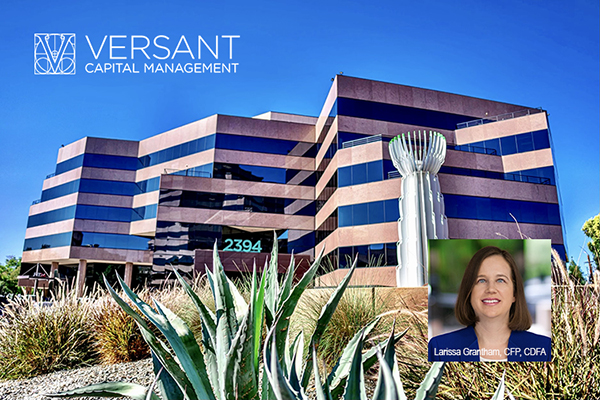Maximizing your savings
By Larissa Grantham, CFP®, CDFA®

A new year is a time to make resolutions, so what better way to impact your financial wellbeing than to check your retirement contributions to maximize your savings? Congress limits how much and when you can contribute, and knowing the rules can help you better save for the future. Many contribution limits for retirement plans increased in 2022, so it is important to reset yourself for making the appropriate amounts. To help you do that, here are the different types of contributions that can be made and their limits:
IRAs & Roth IRAs
IRAs and Roth IRAs are plans where contribution limits didn’t increase in 2022. An individual may contribute a total of $6,000 to their IRA or Roth IRA if they have that amount of earned income, plus an extra $1,000 if they are age 50 or older in 2022. What did change, however, is the income limitations that determine the type of contribution that can be made:
The phaseout for making a deductible IRA contribution
- $68,000 to $78,000 for a single taxpayer covered by a workplace retirement plan
- $109,000 to $129,000 for married couples filing jointly when the spouse making the IRA contribution is covered by a workplace retirement plan
- $204,000 to $214,000 for a taxpayer not covered by a workplace retirement plan, married to someone who is covered
- $0 to $10,000 for married filing separately for taxpayers covered by a workplace retirement plan
The phaseout for making a Roth IRA contribution
- $129,000 to $144,000 for single taxpayers and heads of household
- $204,000 to $214,000 for married filing jointly
- $0 to $10,000 for married filing separately
If you don’t qualify to make a deductible IRA contribution or a Roth IRA contribution but have earned income, you can make a nondeductible IRA contribution. While this type of contribution doesn’t give you a tax benefit for the year you make it, it grows tax free (as other contributions do), often making it a worthwhile investment.
Defined Contributions
The contribution limit for employees who participate in defined contribution plans such as 401(k), 403(b), most 457 plans, and the federal government’s Thrift Savings Plan increased to $20,500, plus an additional $6,500 if the employee is age 50 or older. The total contribution limit for employee and employer contributions increased from $58,000 to $61,000 ($67,500 if age 50 or older). Some of the plans have additional benefits as well.
403(b) Plans
403(b) plans have a “pre-retirement” catch-up limit of another $15,500 in 2022, increased from $15,000. This limit is a lifetime cap, not an annual cap. If permitted by the plan, these special catch-up contributions allow a participant who has completed at least 15 years of service with an organization, to increase their contribution by as much as $3,000 per year over the annual contribution and the age-50 catch-up amounts.
457(b) Plans
457(b) plans have a “pre-retirement” catch-up limit of another $20,500, an annual limit. If permitted by the plan, there is a special “last 3-year catch-up,” which allows you to defer in the three years before you reach the plan’s normal retirement age if you have not maxed out your contributions in the past:
- Twice the annual 457(b) limits (2022 is $20,500 x 2 = $41,000), or
- the annual 457(b) limit, plus amounts allowed in prior years that you did not contribute
- If a 457(b) allows both the age-50 catch-up and the 3-year catch-up, you can use the one that allows a larger deferral, but not both
SEP-IRA
SEP-IRAs increased to the lesser of 25% of compensation or $61,000.
SIMPLE IRA
SIMPLE IRAs increased from $13,500 to $14,000 for 2022 ($17,000 if age 50 or older). Employer contributions are either matching or nonelective ranging from 1% to 3% of compensation, depending on the plan. The employee’s compensation up to $305,000 for 2022 is considered to figure the contribution limit.
Health Savings Accounts (HSA)
While not a traditional retirement plan contribution, these accounts have triple tax benefits:
- A tax deduction in the year the contribution is made for (either on your W-2 or on your tax return depending on whether the plan is through your employer)
- Assets grow tax free while in the account (and there are investment options), and distributions are tax free if you use them for qualified medical expenses
- Contribution limits increased to $3,650 for a single taxpayer ($4,650 if age 55 or older) or $7,300 for family coverage ($8,300 if age 55 or older).
To be eligible to make this contribution, taxpayers must participate in a high-deductible health plan with minimum deductibles of $1,400 for self-only coverage or $2,800 for family coverage and out-of-plan maximums of $7,050 for self-only coverage or $14,100 for family coverage. It’s important to note that contributions made to health savings accounts are in addition to retirement contributions.
Time Frames
It’s essential to know the contribution windows available to you and get yours funded before the windows close. Those who qualify and have not yet funded an IRA or Roth IRA contribution can contribute for 2021 until April 15, 2022. The limits for IRAs and Roth IRAs for 2021 are the same for 2022.
For those making SEP-IRA contributions, the deadline is the same as the tax-filing deadline, which means that if you extend the filing of your tax returns, it could be as late as October 15, 2022. Health savings account contributions can be made for the prior year up to April 15th, as well.
Using your retirement contributions to their full advantage can help increase your opportunities to build comfortable retirement savings. Be sure to know what your options are.
Larissa Grantham, CFP®, CDFA® is a senior wealth counselor at Versant Capital Management, specializing in all aspects of wealth management. As a Certified Divorce Financial Analyst™, she addresses the unique financial issues of divorce to help achieve equitable settlements for our clients in a non-confrontational manner.
Versant Capital Management is a wealth management and investment firm located in Phoenix, AZ serving high net worth individuals, multi-generational families, small business owners, and women experiencing transitional life events since 2004.
Lisa Greve is the marketing and administrative manager at Versant Capital Management, an independent wealth management and registered investment firm serving people and their families since 2004.
